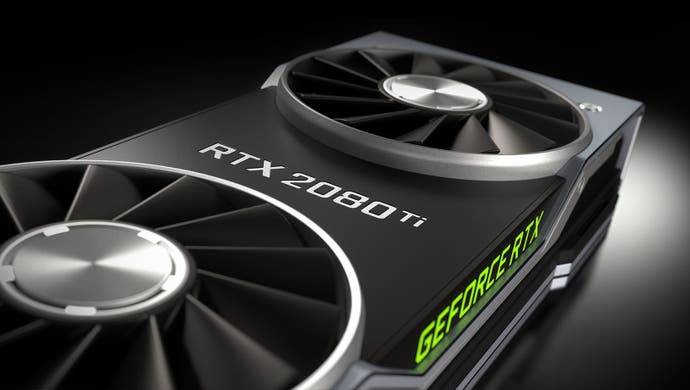Nvidia unveil RTX 2070, RTX 2080 and RTX 2080 Ti at Gamescom
What's in a name? In this case, real-time ray tracing.
After months of leaks and rumours, Nvidia has finally unveiled its new generation of consumer graphics cards at their Gamescom event with the RTX 2070, RTX 2080 and RTX 2080 Ti.
Yes, Nvidia is finally moving on from its GTX naming convention after a decade, while also jumping from 10-series to 20-series cards. RTX refers to real-time ray tracing, a computationally expensive process of accurately modelling how light bounces between reflective surfaces in a scene. Ray tracing in real time has been a holy grail for graphics card makers for years, and it looks like Nvidia has become the first to truly crack this photo-realistic lighting effect.
Nvidia is promising ray tracing performance which is six times faster than previous generation graphics hardware, thanks to dedicated RT cores. Nvidia replayed the Star Wars short they released at GDC in March, and CEO Jensen Huang stated that the four Volta V100 data centre GPUs used to originally render the short are outperformed by a single consumer-grade RTX 2080 Ti - impressive stuff.
In order to allow game developers to make use of Nvidia's real-time ray tracing tech, Microsoft and Nvidia developed the DirectX Ray Tracing (DXR) API. Epic are set to add real-time ray tracing support for Unreal Engine 4 developers by the end of the year, and other large game engines are also expected to announce support for RTX in the weeks to come.
Nvidia also showed off some of the first titles with real-time ray tracing support at the event: Metro Exodus, Battlefield V and Shadow of the Tomb Raider. Metro Exodus is a February 2019 title, while the other two games are set to debut this autumn. The number of RTX games by next year should be considerable, with Nvidia highlighting 21 titles at the event including both existing and forthcoming releases. We won't list them all here, but some big titles included PlayerUnknown's Battlegrounds, Mechwarrior V: Mercenaries and Final Fantasy XV.
Apart from their ray tracing capabilities, the new Turing cards should also offer a considerable performance boost over the previous generation, thanks to a big uptick in the number of CUDA cores and significantly faster GDDR6 memory. You can see how the three new models compare to the previous-gen GTX 1080 and GTX 1080 Ti in the table below. Note two new performance metrics here - giga rays per second, which reflects the card's ray tracing capabilities, and RTX-OPS, which is an average of all of the card's operations including ray tracing, shading and so on.
| RTX 2080 Ti | RTX 2080 | RTX 2070 | GTX 1080 Ti | GTX 1080 | |
|---|---|---|---|---|---|
| CUDA cores | 4352 | 2944 | 2304 | 3584 | 2560 |
| Giga Rays/sec | 10 | 8 | 6 | 1.21 | 1? |
| RTX-OPS | 78T | 60T | 45T | 12T? | 8T? |
| VRAM | 11GB GDDR6 | 8GB GDDR6 | 8GB GDDR6 | 11GB GDDR5X | 8GB GDDR5X |
| Memory Bus | 352-bit | 256-bit | 256-bit | 352-bit | 256-bit |
| Mem. Bandwidth | 616GB/s | 448GB/s | 448GB/s | 484GB/s | 352GB/s |
| Base Clock | 1350MHz | 1515MHz | 1410MHz | 1480MHz | 1607MHz |
| Boost Clock | 1545MHz | 1710MHz | 1620MHz | 1582MHz | 1733MHz |
| TDP | 250W | 215W | 185W | 250W | 180W |
Of course, this spec sheet doesn't tell the whole story, and Nvidia's Turing presentation contained some other interesting nuggets as well. For example, as well as sporting the usual complement of DisplayPort 1.4 and HDMI 2.0b ports, RTX graphics cards will also come with a USB Type-C VirtualLink port. This will be used to allow VR headsets to connect using a single cable, rather than the USB and HDMI combo found on current VR headsets. Nvidia's new cards will also be capable of a maximum resolution of 7680 x 4320 (8K UHD) at 60Hz, although this requires two DisplayPort 1.4 cables to be used. Past Nvidia standards, such as Ansel, G-Sync HDR and NVLink, are of course supported as well; the latter was previously only available on Nvidia's workstation cards.
While Nvidia are using a dual-fan design for their reference models, triple-fan designs seem commonplace for custom RTX 2080 and RTX 2080 Ti cards. Most RTX 2080 cards require one six-pin and one eight-pin power input, while RTX 2080 Ti designs require two eight-pin inputs. A PSU rated for at least 650W is also required to use the new RTX 2080 or RTX 2080 Ti cards. The RTX 2070 is less demanding, requiring only a single eight-pin connector and a 550W power supply. Jensen Huang also promised that the new RTX 20-series cards are seriously quiet, with the new cards boasting "one fifth" the noise of the GTX 1080 Ti when running at maximum overclock.
While some of the hardware specifications for the new RTX cards was leaked ahead of time, pricing and availability information has been harder to come by. During their conference, Nvidia confirmed that the RTX 2070 has an MSRP of $499, while the RTX 2080 moves up to $699. The RTX 2080 Ti is significantly more expensive, coming in at $999. Founders Edition cards will also be available, but will cost more - expect $599 (£569/€639) for the RTX 2070, $799 (£749/€849) for the RTX 2080 and $1199 (£1099/€1259) for the RTX 2080 Ti.
Custom and Founders Edition RTX 2080 and 2080 Ti cards are already available on pre-order, with shipments slated to start on September 20th, 2018. The RTX 2070 will arrive in October, with no precise release date announced as of yet.
- Buy Founders Edition cards from Nvidia [?]
- Buy RTX 2080 and RTX 2080 Ti from Amazon
- Buy RTX 2080 and RTX 2080 Ti from Newegg.com [?]
- Buy RTX 2080 and RTX 2080 Ti from Overclockers.co.uk [?]
- Buy RTX 2080 and RTX 2080 Ti from Ebuyer.com [?]
Stay tuned for extensive Digital Foundry analysis of Nvidia's new graphics generation - including actual in-game benchmark results from these new GeForce RTX cards to see how they rank amongst the world's best graphics cards.






















